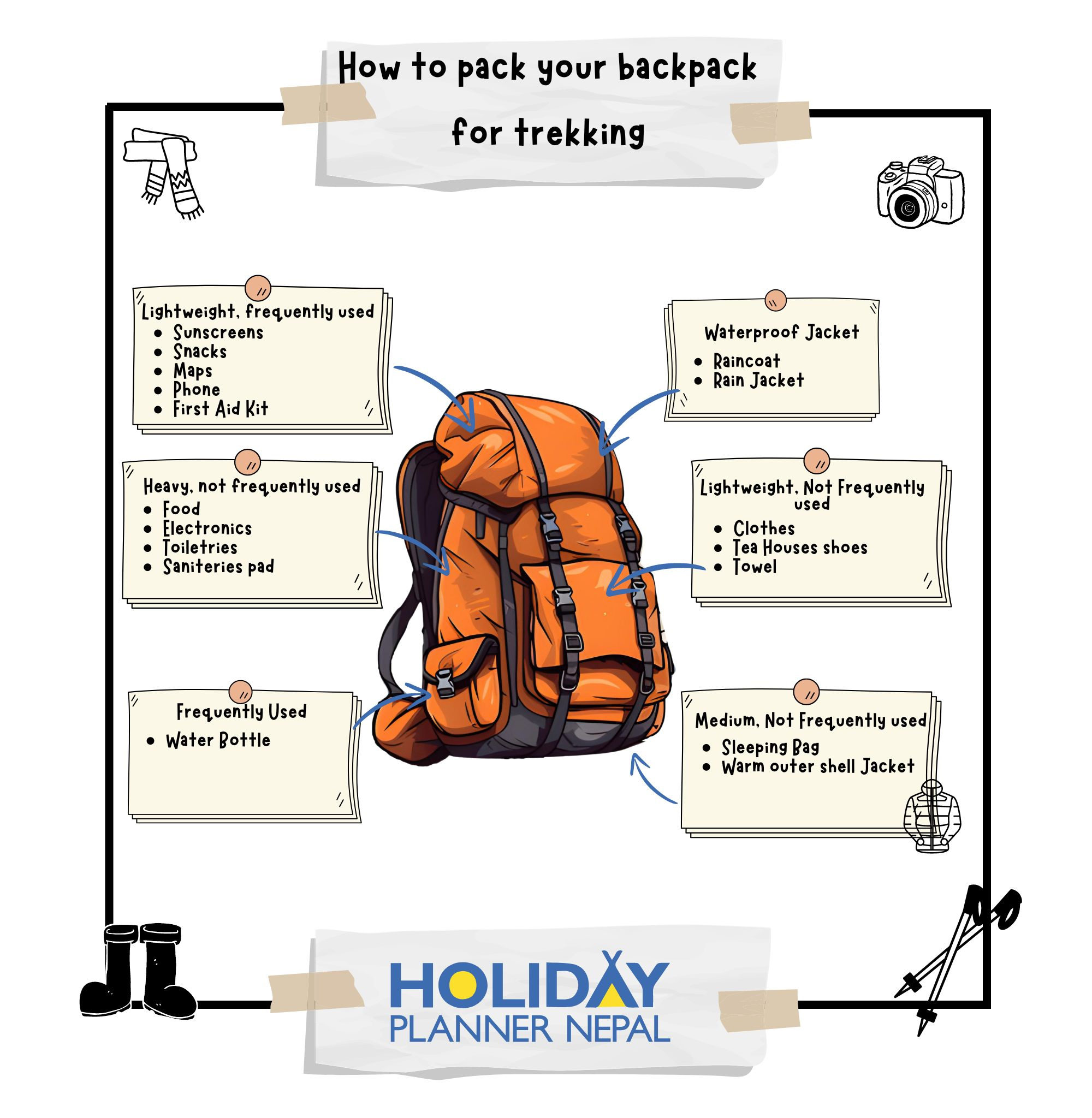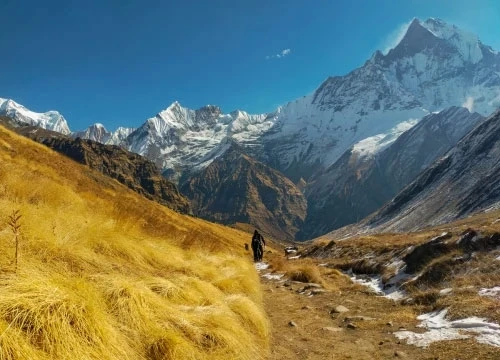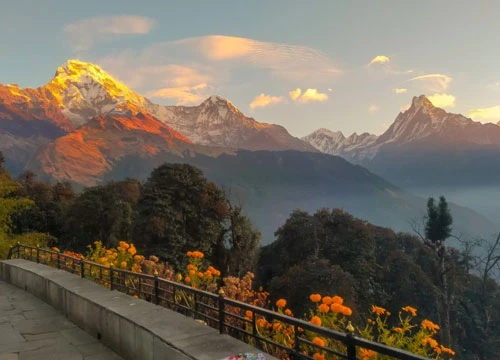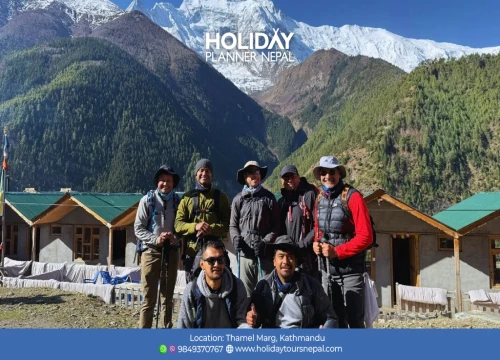Highlights for Annapurna Circuit Trekking
- A legendary trekking trail in Nepal is famous worldwide for the landscape and beauty it poses.
- The Annapurna Circuit Trek lets you witness the mountains of the Annapurna massif: Annapurna I, Annapurna II, Annapurna III, Annapurna IV, Dhaulagiri, Machhapuchhre, Gangapurna, Manaslu, Lamjung Himal, Hiunchuli, and Nigiri.
- Crossing the almighty Thorang La Pass, between the Katung Kang and Yakawa Kang mountains, and walking above the glacier.
- Walking from the subalpine forest to the forbidden desert kingdom of Muktinath.
- From the hot spring of Tatopani to the sunrise view of the mountains turning gold from Ghorepani Poon Hill.
- Witness the harmony between Hinduism and Buddhism along the trail.
"Annapurna Circuit Trek is a full circuit of the Annapurna Trail, which takes you from the rainy side of Nepal to the windy side of Nepal."
Why choose Annapurna Circuit Trekking?
The Annapurna Circuit Trek is one of the most iconic trekking routes in Nepal, attracting adventurers from all over the world. Here are the key reasons why you should choose it:
1. Stunning Scenic Diversity
The trek passes through multiple climatic zones, from lush subtropical forests to arid high-altitude landscapes.
You'll witness terraced fields, deep river valleys, and snow-capped peaks including Annapurna I, Dhaulagiri, and Machapuchare.
The Thorong La Pass at 5,416 m offers breathtaking panoramic views, one of the highest trekking passes in the world.
2. Cultural Experience
The route passes through villages inhabited by Brahmin, Chhetri, Gurung, and Thakali communities.
Trekking here gives you an opportunity to experience traditional lifestyles, local festivals, monasteries, and unique architecture.
You can enjoy local cuisine like dal bhat, momos, and Thakali food.
3. Adventure and Challenge
The trek offers challenging terrains, suspension bridges, high passes, and long ascents, making it a true adventure for trekkers.
Crossing Thorong La Pass is a lifetime achievement for most hikers.
4. Variety in Trekking Options
The circuit can be tailored: classic 14–21 days, shorter versions (10 days) via shortcuts, or extended treks including Muktinath, Tilicho Lake, or Poon Hill.
Options for teahouse trekking, camping, or luxury lodges are available.
5. Accessibility and Infrastructure
The trek starts from Besisahar or Pokhara, both accessible by road or flight.
Well-maintained teahouses, lodges, and trails make it manageable even for solo trekkers.
6. Natural Highlights
Rivers, waterfalls, and hot springs along the way.
Opportunities for wildlife sightings in the Annapurna Conservation Area, including blue sheep, langurs, and Himalayan birds.
7. Photographic Opportunities
With its dramatic landscapes, vibrant villages, and mountain panoramas, it’s a trek perfect for photography lovers.
Major attractions on the Annapurna Circuit Trekking
1. Poon Hill (3,210 m)
Famous for sunrise views over the Annapurna and Dhaulagiri ranges.
A short detour but offers panoramic photo opportunities.
2. Manang Valley
A high-altitude valley with beautiful landscapes, apple orchards, and traditional villages.
A resting point for acclimatization before Thorong La Pass.
Tilicho Lake, one of the highest lakes in the world, is a popular side trek from here.
3. Thorong La Pass (5,416 m)
The highest point of the trek and a major highlight.
Offers breathtaking views of Annapurna, Dhaulagiri, and the Mustang region.
Crossing it is considered a lifetime achievement for trekkers.
4. Muktinath Temple (3,710 m)
A sacred Hindu and Buddhist pilgrimage site.
Known for its 108 water spouts and golden temple, symbolizing spiritual purification.
5. Marpha Village
Famous for apple orchards, traditional Thakali houses, and local apple brandy.
A perfect spot to experience Thakali culture and cuisine.
6. Jomsom
Gateway to Upper Mustang, with breathtaking desert-like landscapes.
Small airport connects trekkers to Pokhara via flight, offering flexibility.
7. Ghorepani
Village known for its lush rhododendron forests and spectacular mountain views.
Often combined with the Poon Hill sunrise hike.
8. Kali Gandaki Gorge
One of the deepest gorges in the world, offering dramatic river valley scenery.
Trek passes through small villages like Syangboche and Kagbeni, showcasing traditional Tibetan culture.
9. Annapurna and Dhaulagiri Views
Continuous panoramic views of multiple 7,000–8,000 m peaks throughout the trek.
Perfect for photography and nature lovers.
10. Hot Springs at Jhinu Danda
Natural hot springs to relax after long trekking days.
A refreshing stop near Chame–Lower Manang route
How does the Trek Begin and End?
The Annapurna Circuit Trek begins with a drive towards Dharapani from Pokhara. After reaching Dharapani, we spend the night there for acclimatization, and the next day we head towards Pisang. After pisang, we go towards the village of Manang, which is a wonderful village. We spend an extra day at Manang for acclamations as we enter inside 3400 m/11154 ft.
After the acclimatization day at Manang, we return to the trail and go towards our destination, Yak Kharka (4,100 m/13,451 ft). After Yak Kharka, we go slowly towards Thorang Phedi. By chance, if you have energy, we recommend pushing to Thorang High Camp, as it will reduce the walk by more than an hour for the next day.
The biggest day of our lives, we begin our day with a walk towards the high camp of Thorang La Pass. We enter the Thorang La Pass between Katung Kang (6,484 m/21272 ft) and Yakawa Kang (6,482 m/21,266 ft) mountains that form Thorang La Pass. Thoran La Pass connects Manang and Mustang, divided by the two distinct rivers of the Annapurna Region, which are famous and known as Marshyangdi and Kali Gandaki.
After crossing Thorang La Pass, we go towards Muktinath Temple, have a bath at the 108 spouts of Muktinath, and then visit the main temple of lord Vishnu. For Hindus, Muktinath represents Lord Vishnu; for Hindus, it represents Mahatma Buddha for Buddhists. Due to the representation of both religions, this place has a different energy that can be felt and is home to the harmonies between Hinduism and Buddhism.
After finishing the prayers and worshipping at Muktinath, we head towards Tatopani.
Take a shared public vehicle towards Tatopani, where, if we reach on time, we can bathe in the hot spring and rest for the day. After Tatopani, we head towards Ghorepani, a beautiful village beneath Poon Hill. Upon reaching Ghorepani, we stayed for the night. The next day, early in the morning, we do a 45-minute hike to Poon Hill, where we will witness one of the most beautiful sunrises ever.
After Seeing the sunrise, we have breakfast, say goodbye to Ghorepani, and leave for Birethanti, where we will take a jeep back to Pokhara, marking the end of our Annapurna Circuit Trek.

Trekking to Annapurna Base Camp: 14 Days Altitude and Distance Coverage
Day | Activity | Altitude (m/ft) | Distance (km/miles) | Duration (hours) | Elevation Gain/Loss |
01 | Arrival in Kathmandu and transfer to the hotel. Evening briefing and welcome dinner. | 1,350 m / 4,430 ft | ~10 km / 6.2 miles (drive) | ~1-2 hrs (transfers + briefing) | — |
02 | Drive from Kathmandu to Dharapani via Besisahar | 1,920 m / 6,299 ft | ~220 km / 137 miles (drive) | ~6-7 hrs (drive) | +570 m / +1,870 ft |
03 | Trek from Dharapani to Chame | 2,670 m / 8,759 ft | ~16 km / 10 miles | ~5 hrs (trek) | +750 m / +2,460 ft |
04 | Trek from Chame to Pisang | 3,230 m / 10,597 ft | ~14 km / 8.7 miles | ~5 hrs (trek) | +560 m / +1,838 ft |
05 | Trek from Pisang to Manang | 3,450 m / 11,318 ft | ~17 km / 10.6 miles | ~5 hrs (trek) | +220 m / +721 ft |
06 | Rest day in Manang for acclimatization and local exploration | 3,519 m / 11,545 ft | ~5-6 km / ~3.7 miles (hike) | ~2-3 hrs (hike) | ~+350 m / +1,148 ft (optional hikes) |
07 | Trek from Manang to Yak Kharka | 4,110 m / 13,484 ft | ~10 km / 6.2 miles | ~4-5 hrs (trek) | +591 m / +1,939 ft |
08 | Trek from Yak Kharka to Thorang High Camp | 4,880 m / 16,010 ft | ~9 km / 5.6 miles | ~4-5 hrs (trek) | +770 m / +2,526 ft |
09 | Cross Thorang-La Pass to Muktinath | 5,416 m / 17,769 ft 3,800 m / 12,467 ft | ~16 km / 10 miles | ~7-8 hrs (trek) | +536 m / +1,759 ft |
10 | Drive from Muktinath to Tatopani | 1,190 m / 3,904 ft | ~85 km / 52.8 miles (drive) | ~5-6 hrs (drive) | -2,610 m / -8,563 ft |
11 | Trek from Tatopani to Ghorepani | 2,874 m / 9,429 ft | ~17 km / 10.6 miles | ~7-8 hrs (trek) | +1,684 m / +5,525 ft |
12 | Sunrise hike to Poon Hill trek to Birethanti, and drive to Pokhara | 3,210 m / 10,531 ft 1,100 m / 3,608 ft | ~20 km / 12.4 miles (total) | ~7-8 hrs (hike + drive) | +336 m / +1,102 ft |
13 | Drive or fly back to Kathmandu | 1,350 m / 4,430 ft | ~200 km / 124 miles (drive) | ~6-7 hrs (drive) | +250 m / +820 ft |
14 | Final international departure from Nepal | — | — | — | — |
Outline Annapurna Circuit Trekking Itinerary
Day 1: Arrival in Kathmandu (1,350 m/4,430 ft) and transfer to the hotel.
Day 2: Drive to Dharapani (1,920 m/6299 ft) in 6 hours.
Day 3: Trek to Chame (2,670 m/8759 ft), 5 hours.
Day 4: Trek to Pisang (3,230 m/10597 ft), 5 hours.
Day 5: Trek to Manang Village (3,450 m/11318 ft), 5 hours.
Day 6: Rest Day at Manang for local hikes and acclimatization.
Day 7: Trek to Yak Kharka (4,110 m/13484 ft), 4 hours.
Day 8: Trek to Thorang High Camp (4,600 m/15091 ft), 4 hours.
Day 9: Cross Thorang-La (5,416 m/17769 ft) and Muktinath (3,800 m/12467 ft) at 7 hours.
Day 10: Drive from Muktinath to Tatopani.
Day 11: Trek from Tatopani to Ghorepani.
Day 12: Hike Poon Hill, trek back to Birethanti, and drive to Pokhara.
Day 13: Drive or fly to Kathmandu, a 6-hour road journey (30 minutes via air).
Day 14: Final international departure from Nepal.


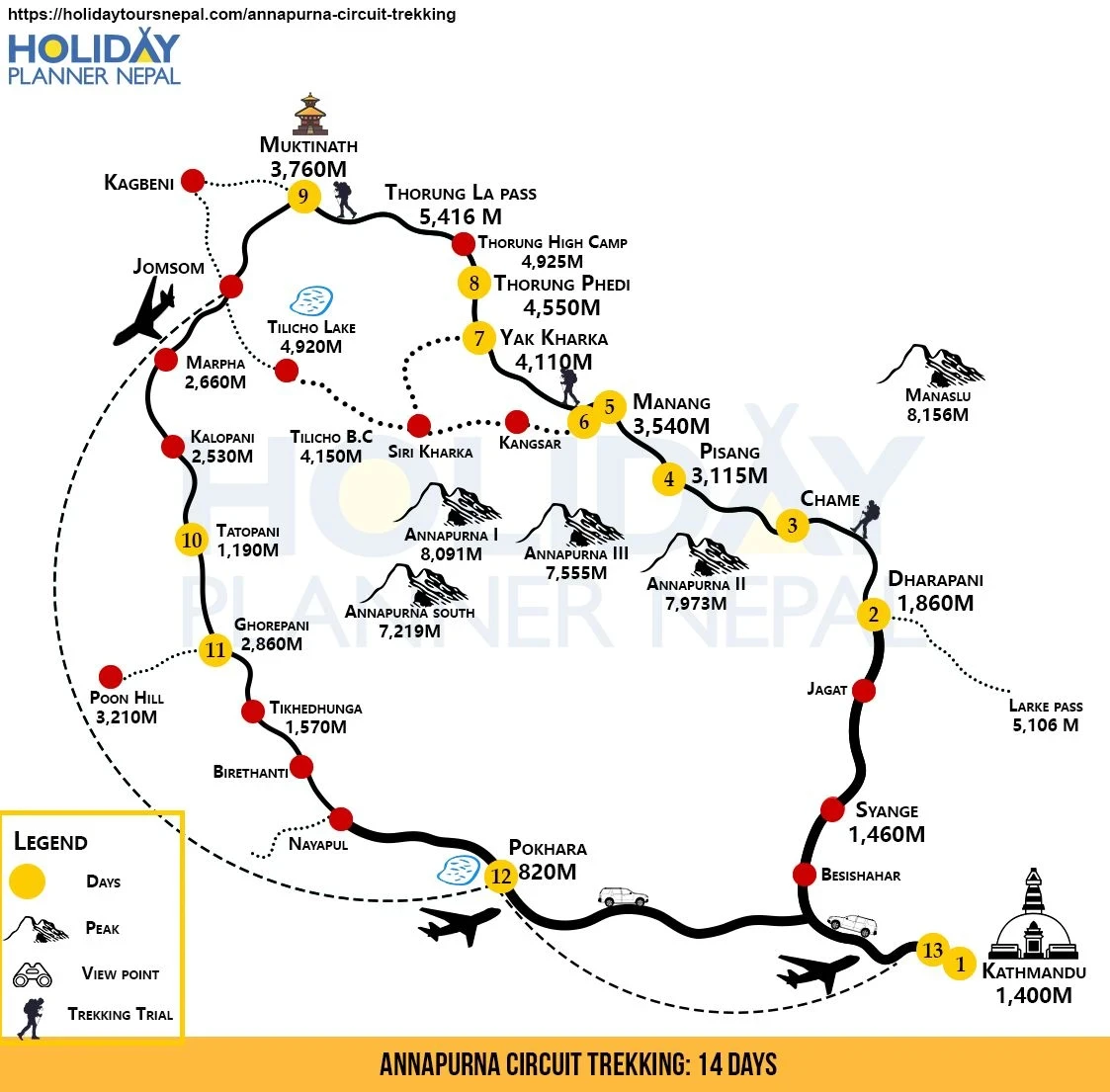
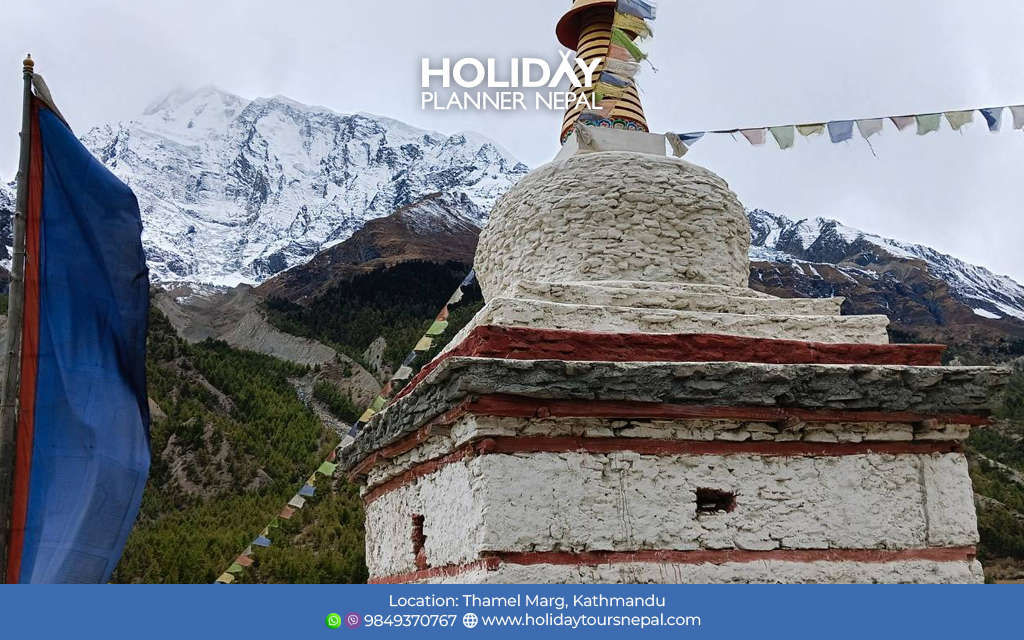
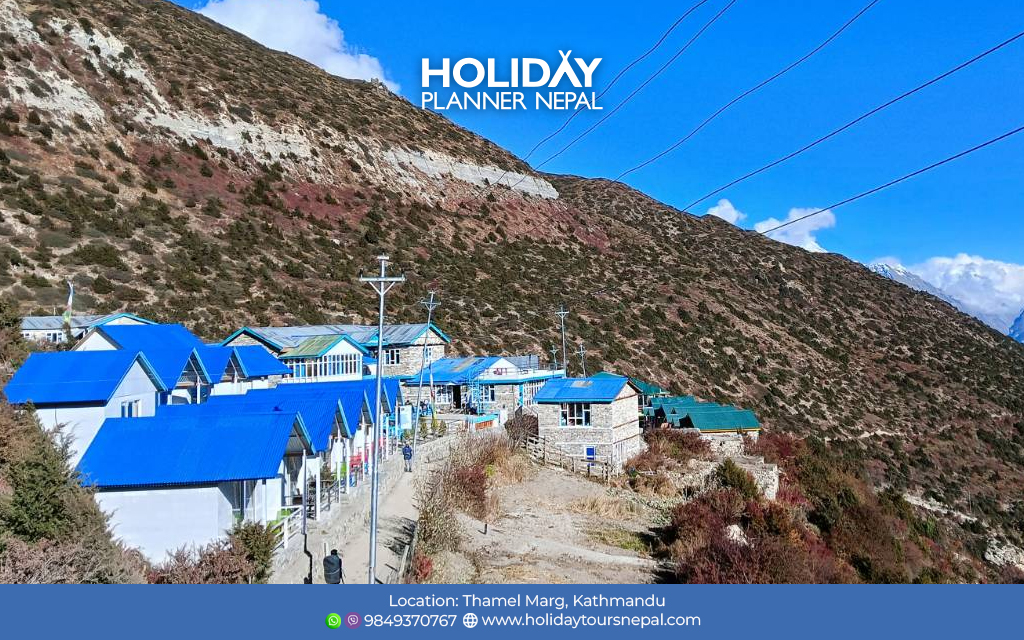
 General
General Upper Body
Upper Body Torso
Torso Lower Body
Lower Body Hands
Hands Feet
Feet Undergarments and Inner Wears
Undergarments and Inner Wears First Aid Kits and Medications
First Aid Kits and Medications Other Essentials
Other Essentials